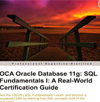Admission
Application Developers, Forms Developer, PL/SQL Developer, Reports Developer, Technical Consultant, Portal Developer, Functional Implementer and End Users
Oracle Database 11g: SQL Fundamentals I
| Exam # |
Duration |
Language |
Level |
Type |
Classroom |
Code |
Fees |
|
-- |
24 |
English |
Professional |
Course |
Classroom |
Cs389 |
0 LE |
Description :
This course introduces students to the fundamentals of SQL using Oracle Database 11g database technology. In this course students learn the concepts of relational databases and the powerful SQL programming language. This course provides the essential SQL skills that allow developers to write queries against single and multiple tables, manipulate data in tables, and create database objects
Objectives :
-
Retrieve row and column data from tables with the SELECT statement
-
Create reports of sorted and restricted data
-
Employ SQL functions to generate and retrieve customized data
-
Display data from multiple tables using the ANSI SQL 99 JOIN syntax
-
Create reports of aggregated data
-
Use the SET operators to create subsets of data
-
Run data manipulation statements (DML) to update data in the Oracle Database 11g
-
Run data definition language (DDL) statements to create and manage schema objects
-
Identify the major structural components of the Oracle Database 11g
Topics :
Introduction
-
Listing the features of Oracle Database 11g
-
Discussing the basic design, theoretical and physical aspects of a relational database
-
Describing the development environments for SQL
-
Describing Oracle SQL Developer
-
Describing the data set used by the course
Retrieving Data Using the SQL SELECT Statement
-
Listing the capabilities of SQL SELECT statements.
-
Generating a report of data from the output of a basic SELECT statement
-
Using arithmetic expressions and NULL values in the SELECT statement
-
Using Column aliases
-
Using concatenation operator, literal character strings, alternative quote operator, and the DISTINCT keyword
-
Displaying the table structure using the DESCRIBE command
Restricting and Sorting Data
-
Writing queries with a WHERE clause to limit the output retrieved
-
Using the comparison operators and logical operators
-
Describing the rules of precedence for comparison and logical operators
-
Using character string literals in the WHERE clause
-
Writing queries with an ORDER BY clause to sort the output
-
Sorting output in descending and ascending order
-
Using the Substitution Variables
Using Single-Row Functions to Customize Output
-
Differentiating between single row and multiple row functions
-
Manipulating strings using character functions
-
Manipulating numbers with the ROUND, TRUNC and MOD functions
-
Performing arithmetic with date data
-
Manipulating dates with the date functions
Using Conversion Functions and Conditional Expressions
-
Describing implicit and explicit data type conversion
-
Using the TO_CHAR, TO_NUMBER, and TO_DATE conversion functions
-
Nesting multiple functions
-
Applying the NVL, NULLIF, and COALESCE functions to data
-
Using conditional IF THEN ELSE logic in a SELECT statement
Reporting Aggregated Data Using the Group Functions
-
Using the aggregation functions in SELECT statements to produce meaningful reports
-
Using AVG, SUM, MIN, and MAX function
-
Handling Null Values in a group function
-
Creating queries that divide the data in groups by using the GROUP BY clause
-
Creating queries that exclude groups of date by using the HAVING clause
Displaying Data From Multiple Tables
-
Writing SELECT statements to access data from more than one table
-
Joining Tables Using SQL:1999 Syntax
-
Viewing data that does not meet a join condition by using outer joins
-
Joining a table by using a self join
-
Creating Cross Joins
Using Sub-queries to Solve Queries
-
Using a Subquery to Solve a Problem
-
Executing Single-Row Sub-queries
-
Using Group Functions in a Sub-query
-
Using Multiple-Row Subqueries
-
Using the ANY and ALL Operator in Multiple-Row Sub-queries
Using the SET Operators
-
Describing the SET operators
-
Using a SET operator to combine multiple queries into a single query
-
Using UNION, UNION ALL, INTERSECT, and MINUS Operator
-
Using the ORDER BY Clause in Set Operations
Manipulating Data
-
Adding New Rows to a Table Using the INSERT statement
-
Changing Data in a Table Using the UPDATE Statement
-
Using DELETE and TRUNCATE Statements
-
Saving and discarding changes with the COMMIT and ROLLBACK statements
-
Implementing Read Consistency
-
Using the FOR UPDATE Clause
Using DDL Statements to Create and Manage Tables
-
Categorizing Database Objects
-
Creating Tables using the CREATE TABLE Statement
-
Describing the data types
-
Describing Constraints
-
Creating a table using a subquery
-
Altering and Dropping a table
Creating Other Schema Objects
-
Creating, modifying, and retrieving data from a view
-
Performing Data manipulation language (DML) operations on a view
-
Dropping a view
-
Creating, using, and modifying a sequence
-
Creating and dropping indexes
-
Creating and dropping synonyms
Recommended Knowledge :
Familiarity with data processing concepts and techniques
Recommended Course(s) :
Database Concepts
Windows Vista Core
Training Materials :
Oracle Press
Labs :
This course includes several labs to ensure you will gain the targeted skills and experience.
Credential :
This course is an essential part of ORACLE11g: Database Administrator Certified Associate (OCA)
Category :
DataBase
The Instructor:
